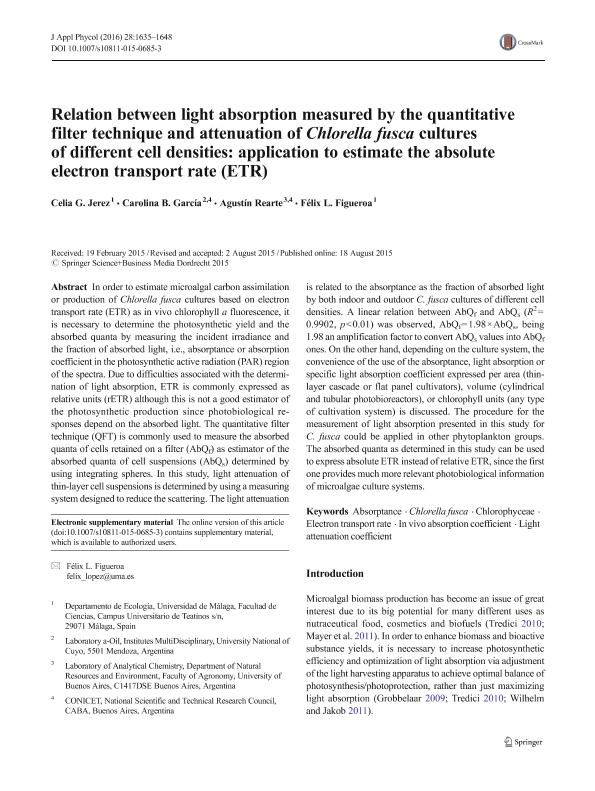Mostrar el registro sencillo del ítem
dc.contributor.author
Jerez, Celia G.
dc.contributor.author
García, Carolina Belén

dc.contributor.author
Rearte, Tomás Agustín

dc.contributor.author
López Figueroa, Félix

dc.date.available
2019-02-04T18:37:41Z
dc.date.issued
2016-06
dc.identifier.citation
Jerez, Celia G.; García, Carolina Belén; Rearte, Tomás Agustín; López Figueroa, Félix; Relation between light absorption measured by the quantitative filter technique and attenuation of Chlorella fusca cultures of different cell densities: application to estimate the absolute electron transport rate (ETR); Springer; Journal of Applied Phycology; 28; 3; 6-2016; 1635-1648
dc.identifier.issn
0921-8971
dc.identifier.uri
http://hdl.handle.net/11336/69336
dc.description.abstract
In order to estimate microalgal carbon assimilation or production of Chlorella fusca cultures based on electron transport rate (ETR) as in vivo chlorophyll a fluorescence, it is necessary to determine the photosynthetic yield and the absorbed quanta by measuring the incident irradiance and the fraction of absorbed light, i.e., absorptance or absorption coefficient in the photosynthetic active radiation (PAR) region of the spectra. Due to difficulties associated with the determination of light absorption, ETR is commonly expressed as relative units (rETR) although this is not a good estimator of the photosynthetic production since photobiological responses depend on the absorbed light. The quantitative filter technique (QFT) is commonly used to measure the absorbed quanta of cells retained on a filter (AbQf) as estimator of the absorbed quanta of cell suspensions (AbQs) determined by using integrating spheres. In this study, light attenuation of thin-layer cell suspensions is determined by using a measuring system designed to reduce the scattering. The light attenuation is related to the absorptance as the fraction of absorbed light by both indoor and outdoor C. fusca cultures of different cell densities. A linear relation between AbQf and AbQs (R2 = 0.9902, p < 0.01) was observed, AbQf = 1.98 × AbQs, being 1.98 an amplification factor to convert AbQs values into AbQf ones. On the other hand, depending on the culture system, the convenience of the use of the absorptance, light absorption or specific light absorption coefficient expressed per area (thin-layer cascade or flat panel cultivators), volume (cylindrical and tubular photobioreactors), or chlorophyll units (any type of cultivation system) is discussed. The procedure for the measurement of light absorption presented in this study for C. fusca could be applied in other phytoplankton groups. The absorbed quanta as determined in this study can be used to express absolute ETR instead of relative ETR, since the first one provides much more relevant photobiological information of microalgae culture systems.
dc.format
application/pdf
dc.language.iso
eng
dc.publisher
Springer

dc.rights
info:eu-repo/semantics/openAccess
dc.rights.uri
https://creativecommons.org/licenses/by-nc-sa/2.5/ar/
dc.subject
Absorptance
dc.subject
Chlorella Fusca
dc.subject
Chlorophyceae
dc.subject
Electron Transport Rate
dc.subject
In Vivo Absorption Coefficient
dc.subject
Light Attenuation Coefficient
dc.subject.classification
Otras Ciencias Biológicas

dc.subject.classification
Ciencias Biológicas

dc.subject.classification
CIENCIAS NATURALES Y EXACTAS

dc.title
Relation between light absorption measured by the quantitative filter technique and attenuation of Chlorella fusca cultures of different cell densities: application to estimate the absolute electron transport rate (ETR)
dc.type
info:eu-repo/semantics/article
dc.type
info:ar-repo/semantics/artículo
dc.type
info:eu-repo/semantics/publishedVersion
dc.date.updated
2019-02-04T13:29:58Z
dc.journal.volume
28
dc.journal.number
3
dc.journal.pagination
1635-1648
dc.journal.pais
Alemania

dc.journal.ciudad
Berlin
dc.description.fil
Fil: Jerez, Celia G.. Universidad de Malaga. Facultad de Ciencias. Departamento de Ecología y Geología; España
dc.description.fil
Fil: García, Carolina Belén. Universidad Nacional de Cuyo. Instituto Multidisciplinario; Argentina. Consejo Nacional de Investigaciones Científicas y Técnicas. Centro Científico Tecnológico Conicet - Mendoza; Argentina
dc.description.fil
Fil: Rearte, Tomás Agustín. Consejo Nacional de Investigaciones Científicas y Técnicas; Argentina. Universidad de Buenos Aires. Facultad de Agronomía. Departamento de Recursos Naturales y Ambiente. Cátedra de Química Analítica; Argentina
dc.description.fil
Fil: López Figueroa, Félix. Universidad de Malaga. Facultad de Ciencias. Departamento de Ecología y Geología; España
dc.journal.title
Journal of Applied Phycology

dc.relation.alternativeid
info:eu-repo/semantics/altIdentifier/doi/https://doi.org/10.1007/s10811-015-0685-3
dc.relation.alternativeid
info:eu-repo/semantics/altIdentifier/url/https://link.springer.com/article/10.1007/s10811-015-0685-3
Archivos asociados
